Are you looking for some fun activities to keep your students’ math skills sharp over the summer break? Do your students need help to achieve mastery of math concepts? Sugar cubes can provide just what you need! One of these activities each week may be enough to boost their math thinking skills, but your students just might want to keep playing and experimenting on their own!
A friend once asked me how I used sugar cubes in math. She had visualized the children just eating the sugar and becoming too hyper for any actual learning! Math manipulatives are nothing more than little things used to illustrate a math lesson, and sugar cubes are fairly inexpensive things that just happen to come in perfect little cube shapes, making them ideal for stacking. However, sugar cubes must be handled with some special care to get them past more than one lesson: do not expose them to moisture (not even wet fingers) and keep them on a jelly-roll pan (large cookie sheet with sides) to collect the crumbs of sugar that will inevitably fall off. Handle the cubes gently to prevent crushing them, but do not be too alarmed when a few of the cubes crumble no matter how gently you touch them. (Life is like that: some of us just can’t take as much pressure as others can.) When lesson time is over, your students can carefully place the sugar cubes back into their box to use them again another day. You will probably want to reserve these sugar cubes for math lessons only — they can become a little too soiled with repeated handling for plunking into your morning coffee! The following suggestions will work with any cube-shaped objects (Cuisenaire Rod 1-units, ABC blocks, dice, etc.), as long as all of the cubes are the same size. A box or two of sugar cubes provides a large number of identical cubes for a small investment, and their plain white sides allow the student to focus on the cubes as units, rather than on any decorative details.
Stack them up, pile them up, square up the piles and see how much fun you can have building walls and tiny forts with sugar cubes. Make checkerboard designs or pyramids. Lessons can be much more than boring drill, and you can learn from play! Below are some more structured lessons to try after a free play session. Some parents may need to do these experiments with their children; other parents may need to get out of the way and just let their child experiment to his heart’s content!
Addition is very simply illustrated through counting the total number of cubes that results from combining this group of cubes with that group of cubes. Take this operation to its next logical level and un-do the addition of cubes for a simplified lesson in subtraction. A student who can see that subtraction is nothing more than backwards addition will not be confused into thinking that subtraction is a new and confusing mathematical concept. Illustrate how addition and subtraction are linked together by discussing both concepts with one set of math facts: 2 cubes in this group plus 3 cubes in that group equals 5 cubes all together: 2 + 3 = 5. Therefore, taking 3 cubes away from 5 cubes leaves us with 2 cubes again: 5 – 3 = 2. Switch the numbers around to show that 3 + 2 also equals 5, and 5 – 2 = 3. Experimenting with just those 5 cubes, the student will quickly see that 1 + 4 = 2 + 3, and so on. Repeat these experiments with other groupings of cubes, always focusing on undoing the addition to prove that the subtraction facts are just another way to state the matching addition facts.
An important part of math is learning about prime numbers. Start with just 1 cube and by adding 1 more cube at a time, we will experiment with making different arrangements of the cubes. Any number of cubes that can make only 1 row is called a prime number — it has multiplication factors of only itself and 1. (One by itself does not count as a prime, because it has no factors at all — it’s just one.)
If you have arranged cubes into two equal rows, that means you have at least 4 cubes. Those can be arranged into 1 row of 4 cubes (or 4 rows of 1 cube each), or 2 rows of 2 cubes each. These are also the multiplication factors of 4: 1 x 4, 4 x 1, and 2 x 2.
Add 2 more cubes, 1 to each row, for a total of 6 cubes. Those can also be arranged into 1 row of 6 cubes (or 6 rows of 1 cube each) or 2 rows of 3 cubes each. Now rearrange the cubes into 3 rows of 2 cubes each to prove that 2 x 3 makes the same size and shape of rectangle as 3 x 2, but just turned the other direction.
Add 2 more cubes, for a total of 8 cubes. Arrange these into 1 row of 8 cubes, then 2 rows of 4 cubes each, and also 4 rows of 2 cubes each. Factors of 8 are: 1 x 8, 2 x 4, 4 x 2, 8 x 1.
So far, an odd number of cubes has not been able to make any even arrangement of rows except for 1 row of cubes. Add 1 more cube to your grouping, for a total of 9 cubes. This is the first odd number that has other factors besides itself and 1: 1 x 9, 9 x 1, and 3 x 3. Arrange the 9 cubes into 3 rows of 3 cubes each.
Show your student that his experiments have now proved that an odd number times an even number equals an even number (3 x 2 = 6). An even number times an even number equals an even number (2 x 4 = 8), and an odd number times an odd number equals an odd number (3 x 3 = 9). Those principles will remain true no matter which odd or even numbers are used — encourage your student to experiment with his sugar cubes to prove this fact.
As the child continues adding more cubes and rearranging them into factor groups, have him make a list of the factors for each number, seeing how many different ways each number can be factored. Which number (of the ones he has tried so far) has the most factors? Multiplication is nothing more than a short-cut to addition, and multiplying can save a lot of time that would be spent adding. Multiplying with bigger numbers will be much faster than adding those numbers over and over and over.
This process can also be done in reverse to illustrate division. Take a random number of sugar cubes and arrange them into rows. Can you make several rows with an equal number of cubes in each row, or do you end up with a few leftover cubes? Try several different arrangements of rows and numbers of cubes in each row. Keep trying until 1) you can come out with a square or rectangular arrangement with no leftovers, or 2) you prove that you have a prime number of sugar cubes, with no other factors than this number and 1. Whether you are multiplying or dividing, the factors remain the same — proving that division is just un-doing multiplication. The only difference is that when dividing, sometimes you can end up with a few leftovers, called the remainder.
Area is basically the same as a set of factors. It can also be thought of as floor tiles by looking straight down on top of the cubes so that only their tops can be seen. By moving the cubes around, the student can demonstrate how 1 x 12, 2 x 6, 3 x 4, 4 x 3, 6 x 2, and 12 x 1 all have the same area (they all use exactly 12 cubes). Area of a square or rectangle is determined by multiplying two connecting sides together, just like the two factors.
Perimeter can be related to how many sections of “fence” it would take to go around the outside of a certain area. The cubes’ edges can be counted as individual fence sections for an easy way to prove how many fence sections are required. Notice that each corner-cube has two exposed edges for fences. Perimeter is usually determined by adding the totals of the sides together, but multiplication can be used as a shortcut for perfect rectangles: 2 times the shorter side, plus 2 times the longer side. (Note that in a single row of cubes, the cube at each end will have 3 exposed sides to be counted.)
Experiment with various arrangements of the same group of cubes and compare the area to the perimeter. Can you change the perimeter without changing the area? What is the largest or the smallest perimeter you can make while keeping the same area?
Volume can be thought of as area in several levels. First, think of area as being a flat concept, like floor tiles, and volume being a 3-dimensional concept, like the solid sugar cubes. Arrange 2 rows of 3 cubes each, making an area of 6. Now arrange 6 more cubes in exactly the same pattern. If you stack one group on top of the other group, you can easily see 2 layers of 6 cubes each. Two rows times 3 cubes times 2 layers equals a volume of 12 cubes: 2 x 3 x 2 = 12. Try this with other groups. Multiply to find the volume: the number of rows times the number of cubes in each row equals the area of that layer. Now multiply the area times the number of layers to find the volume. How many more cubes does it take to increase the total volume of the stack of cubes?
Once your student has mastered calculating volume, combine it with measurements. Have him measure the side of one sugar cube, and then substitute that measurement in his calculations of perimeter, area, and volume. Now have him measure the sides of the large stack of sugar cubes to see if his calculations were correct. Substitute 1 inch for the measurement: if the sugar cubes measured 1 inch on each side, how large would the stack be now? How large would a stack be with 10 layers of 10 rows of 10 sugar cubes in each row? How about a stack that had 100 cubes each direction? How about 1,000? Or a million? Or a billion? (This leads directly into the study of exponents, because a square of x-number of sugar cubes is x2 and a cube of x-number of sugar cubes is x3.) How many sugar cubes would it take to make a large cube (all 3 sides equal) the approximate size of a card table? Or as tall as your house? Or as wide as a football field? Your students may need to use a calculator to check their math on these problems, but getting to use the calculator is their reward for having fun with math!
By the time your student has completed all of the activities listed above, he has probably also thought of some other activities to try with the sugar cubes. Try them–experimenting is how we learn!

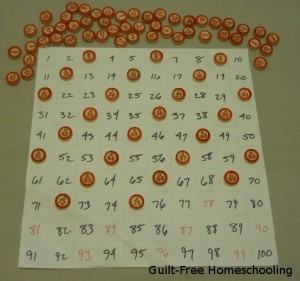
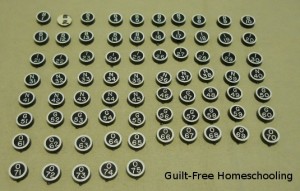

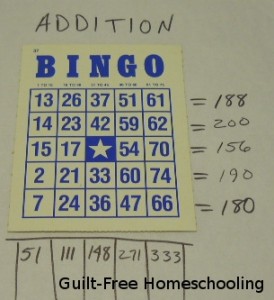
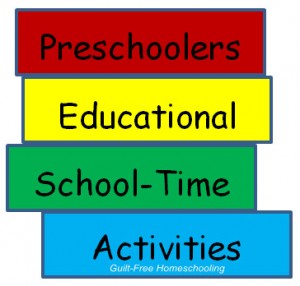
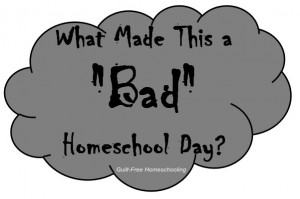



 Guilt-Free Homeschooling is the creation of Carolyn Morrison and her daughter, Jennifer Leonhard. After serious disappointments with public school, Carolyn spent the next 11 years homeschooling her two children, from elementary to high school graduation and college admission. Refusing to force new homeschooling families to re-invent the wheel, Carolyn and Jennifer now share their encouragement, support, tips, and tricks, filling their blog with "all the answers we were looking for as a new-to-homeschooling family" and making this website a valuable resource for parents, not just a daily journal. Guilt-Free Homeschooling -- Equipping Parents for Homeschooling Success!
Guilt-Free Homeschooling is the creation of Carolyn Morrison and her daughter, Jennifer Leonhard. After serious disappointments with public school, Carolyn spent the next 11 years homeschooling her two children, from elementary to high school graduation and college admission. Refusing to force new homeschooling families to re-invent the wheel, Carolyn and Jennifer now share their encouragement, support, tips, and tricks, filling their blog with "all the answers we were looking for as a new-to-homeschooling family" and making this website a valuable resource for parents, not just a daily journal. Guilt-Free Homeschooling -- Equipping Parents for Homeschooling Success!

Recent Comments